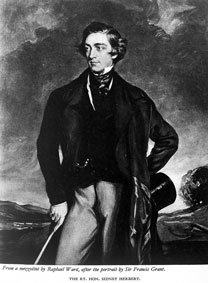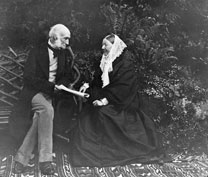This content is adapted from the Florence Nightingale Derbyshire Association’s Exhibition (2010)
The material in this section is not the result of research by the current project team, but rather is adapted from the Florence Nightingale Derbyshire Association’s 2010 Exhibition, which marked the 100th anniversary of the death of Nightingale and was displayed throughout August 2010 at the Gothic Warehouse, Cromford Wharf, part of the Derwent Valley Mills World Heritage site. An associated programme of music, dance, film and walking events were held throughout Derbyshire.
We would like to thank the Florence Nightingale Derbyshire Association for permission to reproduce these materials.
The Reform Years
God has never left me quite alone.
- Florence Nightingale
For twenty years after her return from the Crimea, Florence Nightingale devoted her life to her work. Her days were spent in detailed research and statistical analysis. She amassed her data, formulated her arguments, then lobbied her influential contacts in government and the Army with advice and recommendations.
She wrote hundreds of books, reports and publications of all kinds and produced an enormous volume of around 14,000 letters. Florence mellowed in the years following her mother's death in 1880. The effects of Crimean Fever abated and she regained more of her positive and engaging disposition.
Although still actively engaged in her reform work, she was a frequent visitor to Claydon House, the home of Sir Harry Verney, her brother-in-law.
From 1900 her health deteriorated. By now completely blind and bedridden, she depended on a housekeeper. Still fierecly independent, there is a story that her house keeper would tuck her up in bed, whereupon she would get up, and in turn tuck up the housekeeper!
1856-61: Little Time to Complete God's Work
On her return from the Crimean War Florence Nightingale thought her death was imminent and that she had little time to complete God's work.
Together with Sidney Herbert and others, she formed a little 'War Cabinet', and in a 'white hot zeal of reform' they began to undertake fundamental changes in army welfare.
The 'War Cabinet' worked closely together from 1856 to 1861, when Sidney Herbert died. In the same year, Florence lost another close friend, Arthur Clough. She was devastated.
Personal Circumstances in Years of Reform
For decades, Florence Nightingale suffered severe back pain and depression, as a result of the mystery illness, thought to be Brucellosis, which she first contracted in the Crimea. This illness finally burnt itself out in the 1880s.
In order to achieve her vast output of work during this period, she lived alone and worked from her room, seeing people only one at a time. She entertained her guests well, but never ate with them. This saved an immense amount of time she would otherwise have spent travelling.
There was little room in her life for the distractions of a family: 'God has clearly marked me out', she once wrote, 'to be a single woman'.
Her illness, social isolation and the prodigious challenge of work often made her demanding and irritable. She constantly challenged her own performance, questioning whether she had succeeded in carrying out God's work to its ultimate perfection.
Her friend and spiritual guide Benjamin Jowett wrote to Florence in 1879:
'There was a great deal of romantic feeling about you when you returned home from the Crimea'.
'And now you work on in silence, and nobody knows how many lives are saved by your nurses in hospitals; how many thousand soldiers are now alive, owing to your forethought and diligence; how many natives of India have been saved [...] by the energy of a sick lady who can scarcely rise from her own bed'.

‘Sidney Herbert, 1st Baron Herbert of Lea', mezzotint by George Raphael Ward, published 29 November 1847 by Paul and Dominic Colnaghi & Co, after Sir Francis Grant. National Portrait Gallery, Creative Commons licence CC BY-NC-ND 3.0.
Mellow Years - Claydon House
In the years after her mother's death in 1880, Florence Nightingale mellowed. Her health improved and she had more time to enjoy the company of her sister Parthe and brother-in-law Sir Harry Verney.
Florence made many visits to Claydon House near Aylesbury, Buckinghamshire, the home of Sir Harry, and saw them frequently in London, since they had a house in the same street.
She particularly delighted in the company of the Verney children and grandchildren, who would often come to visit her in London.

'Florence Nightingale and Sir Harry Verney', photograph, n.d. Wellcome Collection, Creative Commons licence CC BY 4.0.
Later Years of Reform and Death
Florence Nightingale nevertheless continued her pioneering reform work for the next twenty years. She remained interested and active - in army medical reform, nursing reform, Indian sanitation, workhouse reform, midwifery and many other projects - untill well into the 1890s: the India Office only stopped sending her reports in 1906, when she was 86!
Florence Nightingale died on August 13th 1910. She was ninety. She was buried, not in Westminster Abbey, but in the family grave at St Margaret's, East Wellow in Hampshire. She had asked for a simple cross to mark her grave and that no more than two people should accompany her body to the cemetery. In fact her coffin was carried by six sergeants from the Guards.
Her gravestone is simply marked - 'FN: Born 12 May 1820. Died 13 August 1910'. In death, as in life, Florence Nightingale sought personal anonymity in the greater presence of God.

Photograph of Nightingale by Millbourn. Wellcome Collection, Creative Commons licence CC BY 4.0.